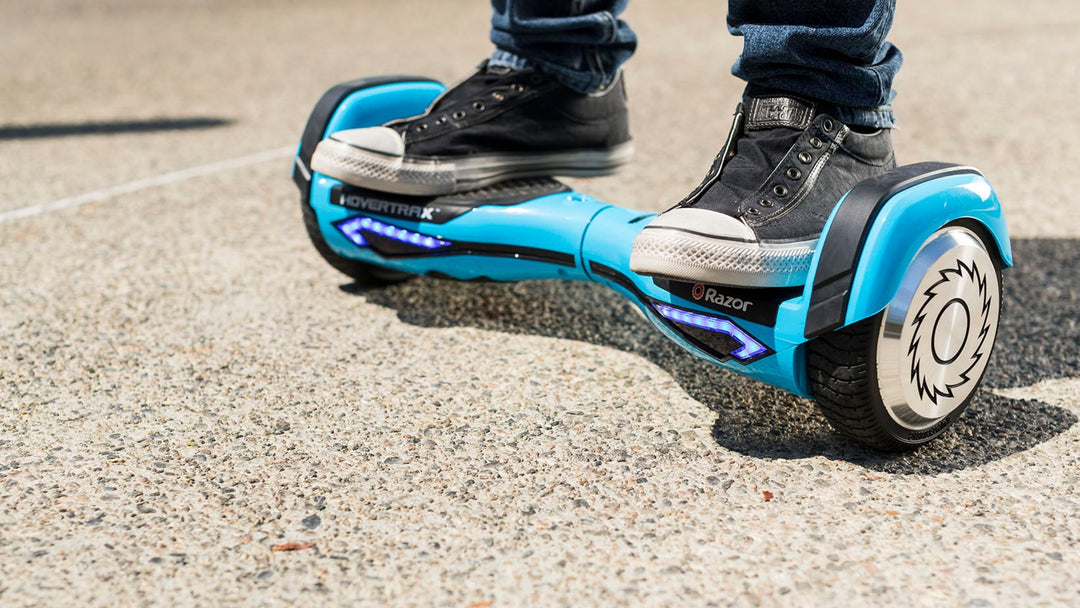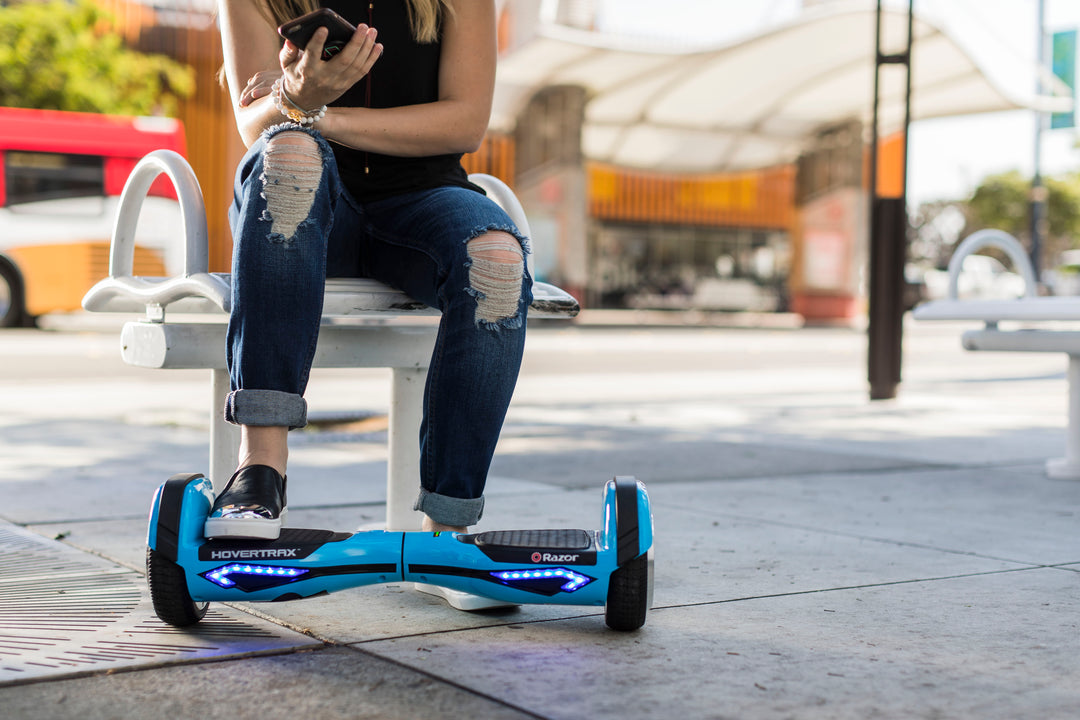Hoverboard Speed: How fast do they go?

Hoverboards are the latest craze everyone can’t get enough of. Even celebrities can’t help but share their love for this high-tech invention. They’re often talked about in the same breath as electric scooters and bicycles as alternative modes of transportation and mobility that are increasingly popular today. Hoverboards are popular because of the convenience they provide but also their speed. Compared to scooters, just how fast can hoverboards go?
Different models can reach varying speeds, that’s why it’s so important you do your research before buying a hoverboard. The Hovertrax Prizma specifically, can reach a maximum speed of 14.5 km/h with the Hovertrax Brights not far behind at 11.2 km/h. That’s right behind most electric scooter speeds and at least double the speed of a kick scooter, which averages about 4.8 km/h, depending on the rider. There are other hoverboards that may reach speeds exceeding these limits but sometimes the safety of those products is questionable.
Although those listed for the Hovertrax models are the operating speeds, how fast a rider should go depends on their age, skill level, and comfort being on the hoverboard. A younger rider who is starting out won’t likely want to go the max speed right out of the gate. Whereas, an experienced rider will feel carefree at higher levels. It all comes down to the individual and what they want out of their hoverboard experience. There’s a default training mode for each hoverboard that allows riders to work up to faster speeds. Switch back and forth between this and normal mode whenever there’s a new rider or you want to go at a slower speed.
However, regardless of the age or skill level you’re at, the thrill of going fast is why many like to ride hoverboards in the first place. It’s a feeling like no other because it’s a one-of-a-kind experience not felt by riding a bicycle. But, maybe the question isn’t how fast do hoverboards go? Maybe it’s, can you handle the speed?
WHAT FACTORS CONTRIBUTE TO HOVERBOARD SPEED?
There are several factors that contribute to hoverboard speed, such as rider weight, road/ground conditions, and the level of battery charge. Hoverboards have a recommended weight limit in order to operate properly. For example, the Hovertrax weight limit range is from 50kg – 80kg. The rider weight maximum is a guide per person. There should never be more than one rider on a hoverboard at a time. It’s too risky plus it may cause damage to the system. Heavier rider weights may lead to slightly slower rides than when someone lighter is onboard. Anything on wheels that’s overloaded will need to use more energy to go faster. Too much weight can affect the battery charge as well.
Road/ground conditions are another contributing factor that affect speed. Obviously, traveling downhill affects how fast you’ll go and could shift your weight to a point where you’ll be unbalanced. It’s recommended to stick to flat, dry surfaces to maintain optimal hoverboard speed and reduce risk of injury. If you encounter uneven surfaces or rockier roads, slow down if you can’t avoid them. Bumpy, rough surfaces put you at an increased risk and can cause damage to the undercarriage of the hoverboard.

Also, as tempting as it may be, resist splashing through water puddles or mud. The hoverboard is powerful but as an electrical unit, it’s not ideal to drag it through these kinds of conditions. This will definitely slow down the speed. Obstacles of any kind will slow down the rider or affect the hoverboard’s functionality. If the hoverboard becomes immersed in water, the electrical and drive conditions could be damaged.
Lastly, the battery will affect how fast you’re able to go as well. All Hovertrax models have a hoverboard battery life of at least 30-45 minutes. You’ll have quite a long ride time before having to recharge for another trip. Check for damage to the cord and plug regularly to ensure it’s not damaged. A low battery will result in slower speeds. Take care in charging the battery after every ride.
The initial charge time is six hours before taking your first ride. The maximum recommended time to charge the battery is 24 hours. Remember to unplug the charger when not in use and switch off the hoverboard when not riding. Otherwise, the battery may no longer hold a charge if it’s left on for an extended period of time (even if not riding). A rider’s weight, the road conditions, and constant stops and starts all affect the speed and also, the battery time. Consider all of these factors as you think about how fast you want to go.
HOW FAST SHOULD I GO?
The short answer to how fast you should go is: as fast as you’re comfortable with. It all depends on how long you’ve been riding your hoverboard, where you’re riding it, and how fast is appropriate for the situation. For example, if you’re a seasoned rider out in the open with little to distract you, the maximum hoverboard speed may be a-ok. On the other hand, if you’re getting used to balancing, speed is probably lower on the priority list. There’s no recommended speed per age or per area but it’s up to you and whoever you’re with to decide how fast you should go for your ride.
Encourage children to start at slower speeds so they can truly get a feel for the hoverboard and understand how it operates. Although 8 km/h may not seem fast when compared to riding in a car, it’s quite a thrill when simply standing on your own two feet. This kind of power requires control that takes getting used to, especially when there are no handlebars or brakes to rely on. It’s perfectly acceptable to ease into the hoverboard experience by slowing upping the speed a little at a time.
Something additional to note is that in short increments of time, the Hovertrax is capable of exceeding the normal operating speed, which is designed to permit the wheels to react and “re-balance” the unit by leveling itself. Don’t try to force it to continually operate at these excessive speeds because control will be more difficult and injuries more likely. To go faster, press the foot platforms at a greater angle and reduce the angle to slow down. It may seem like leaning forward will make you go faster, but it’s only the direction of the feet that make it speed up or slow down. Shifting your weight doesn’t equal stability. Exaggerated leaning could make you lose your balance and lose control of the hoverboard altogether.
Finally, when considering hoverboard speed, follow the rules of the road and all legal and public policies. Although you’re not going as fast as cars, bikes, or electric scooters, you still need to abide by traffic laws and general road courtesy. Call out if you’re right behind someone or passing on the left. Each city has its own rules on where you can ride hoverboards and it’s up to you to abide by them. A busy boardwalk may not be the best place to cruise at your fastest; whereas, an empty park area could be the perfect place. Use your best judgment before becoming a speed racer. It’s safer and ultimately, more enjoyable for all.
SAFETY AFFECTS SPEED
Fast speeds are exciting but so are the many other hoverboard features like uninterrupted ride time thanks to a long battery life.
There may be hoverboards on the market that reach faster than 14 km/h, but they aren’t always the safest or best quality. Razor holds the patent for the original hoverboard and is the first U.S. brand to receive the UL 2272 listing for safety. Yes, speed is one of the biggest draws to riding, but hoverboards are a blast no matter how fast you go. Don’t settle for less than the best. Kids and kids-at-heart love the thrill of stepping onto a hoverboard and speed is only one part of the fun. The priority is for everyone to get where they’re going safely.
No matter how comfortable you get on a hoverboard, safety should always be a priority, like wearing a seatbelt in the car. The first rule is to wear a helmet to protect your head in the event of running into someone or something. Secure it with a chin strap and think about additional padding (elbow pads and knee pads) for extra protection. Also, make sure to keep your shoes on when riding. You won’t get a better grip than what the anti-slip rubber platform provides. No bare feet and no sandals.

Make it a habit to run through a quick equipment check every time you ride. Look for the following:
- Wheel damage. Practice riding only in open areas clear from curbs, parking blocks, and other obstacles. Hitting the wheels against a hard surface can cause damage and wheels aren’t covered under the limited warranty.
- Loose parts. Over time, nuts, fasteners, and other hardware may become loose. Listen for any unusual sounds and check for any broken components so you can get it repaired or order a replacement right away. Suffice it to say, no one rides until it’s 100% ready to go.
- A full battery charge. When all lights are illuminated it means the battery is sufficiently charged. Only red and orange indicator lights mean you’ll need to charge the battery as soon as possible, and a flashing red light accompanied by rapid beeping means charge right away. The recommended recharge time is up to 4 hours. If the light turns green prior to this span of time, keep charging to make sure it gets enough juice.
Another hoverboard safety tip to note is periodic recalibration. The Hovertrax is calibrated at the factory but you’ll want to test it when first starting. Over time, you may need to recalibrate it to assure “level” status. If calibration is off for too long, it could affect how the unit operates and impede speed. It could send instructions to the motor to move differently than what you intended, meaning it could zig when you wanted to zag.
It’s easy to recalibrate the Hovertrax. Simply turn the power off and manually adjust the platforms to be parallel to the ground. Turn the power back on and hold for about 20 seconds until it beeps and lights flash. Then, turn the power back off and calibration is complete. The next time you turn it on to ride, the platforms will automatically self-balance themselves back to the calibrated position.
THE NEED FOR (HOVERBOARD) SPEED
We admit it, going fast is exhilarating. However, hoverboard speed isn’t the only thing this “magical” mobility system has going for it. Consider all the factors before deciding how fast to go; age, rider weight, environment, skill level, and whatever makes you feel safest. Make safety the priority and take into account all the other cool features and colors that are included.
One of the many joys of riding a hoverboard is the unique experience it brings. It’s not like anything else you’ve ever been on, which makes this smooth ride an adventure all on its own. It’s nothing but you in the great outdoors, balancing on the platform and letting your feet get to the work. Enjoy the ride as fast or as leisurely as you’d like. Either way, you’re in for one awesome ride.





